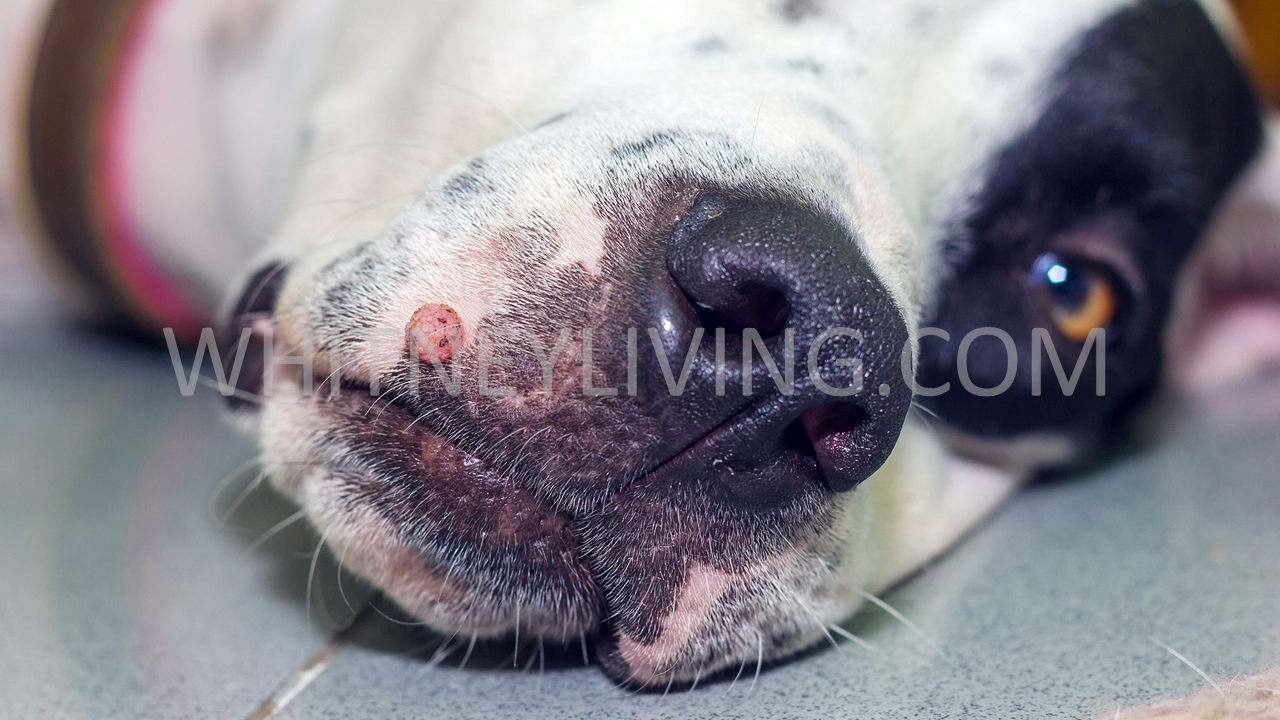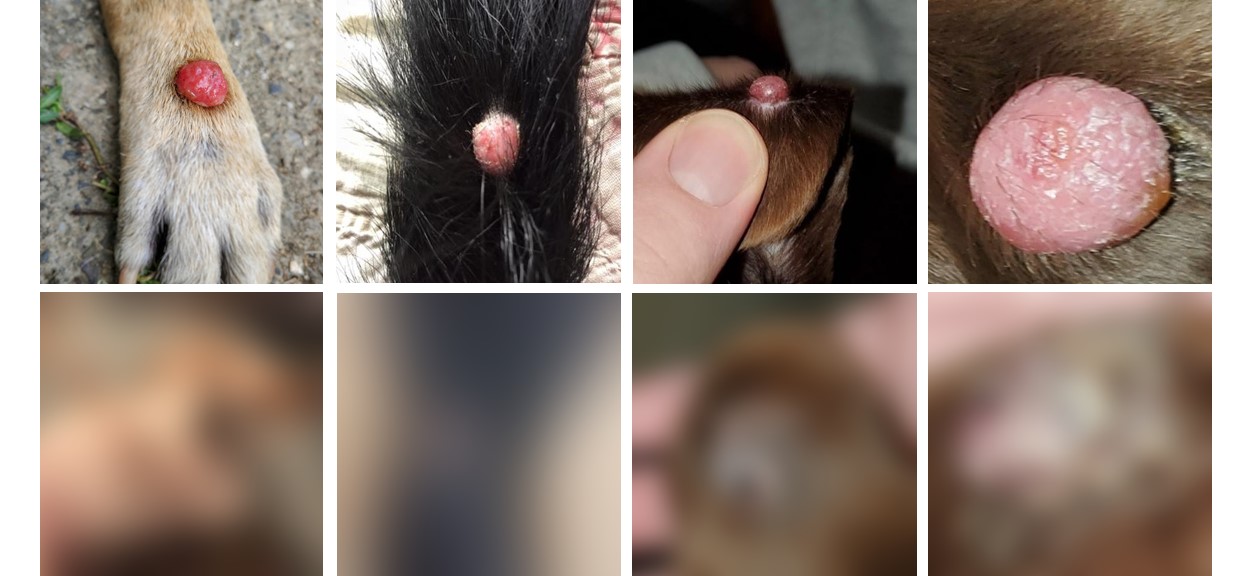Histiocytoma dog home treatment options are simple, inexpensive, and safe. You can easily heal your dog’s histiocytoma at home with apple cider vinegar and I’ll share how.
What Are Histiocytomas?
Histiocytomas in dogs are benign. They are rapid cell growth that can be seen on the surface of the skin.
Histiocytomas pop up more often on dogs under the age of two. The skin growth is scary to find and often mistaken for a cancerous tumor, so a proper diagnosis by your vet is recommended. Treatment may not be necessary if it regresses on its own, but if the skin growth causes discomfort or is at risk of becoming infected, it may be removed with an all-natural, safe at home treatment like ACV. Surgery is rarely needed, though your vet may be quick to unnecessarily recommend surgery.
Types of Dog Histiocytomas
There are several types of dog histiocytomas. Knowing which your dog has will help determine the histiocytoma dog home treatment needed. While the benign cutaneous histiocytoma is the most common type, there are some more serious yet rare types of canine histiocytomas. There are also rare conditions that are related to histiocytes (the immune cell that lives in the skin).
Malignant histiocytoma: In very rare cases, histiocytomas can become malignant. Malignant histiocytomas can metastasize to local lymph nodes. Again, this is extremely rare but something to keep in mind.
Localized histiocytic sarcoma: This is a rare condition that also causes swelling in the limbs and lameness. Localized histiocytic sarcoma may be a focal solitary lesion or be in the form of multiple nodules within a single organ.
Disseminated histiocytic sarcoma (malignant histiocytosis): This is an extremely rare but severe condition that affects all of the dog’s organs. The condition causes lethargy, weight loss, and loss of appetite. It is extremely serious and often fatal.
Malignant fibrous histiocytoma (MFH): This is a type of soft tissue tumor. It’s usually found as a lump under the skin. Testing will find it to be a malignant fibrous histiocytoma. They are locally invasive and can metastasize, so surgical removal is recommended.
Why A Histiocytoma Dog Home Treatment Is Better?
A histiocytoma dog home treatment is an overall better health option because it can improve their health as they heal. it’s always best to use remedies that improve the overall health of your dog and I’m here to share with you exactly how to do that and what remedies to use.
In most cases the remedies that a vet will prescribe you for your dog are going to negatively affect their overall health during the time that you use them and also for some time after you stop using them. you can avoid this by opting out of prescription medications when possible.
Sometimes, prescription medications and harsher treatments are necessary in lifesaving instances so sometimes it’s not possible to avoid those completely but anytime you can opt for an all-natural treatment it will be better for your dog’s overall health.
There are a plethora of risks associated with conventional medical treatments. These risks can include everything from allergic reactions to death (in tragic cases).
Like I said above sometimes you must weigh the risks when it comes to your dog’s health and safety and choose the option that may be responsible for saving their life, even if you don’t find it to be an ideal option.
But, when you can, choose treatments that don’t have a great risk associated with them. All-natural treatments can take a little bit longer to work but, in my opinion, they are well worth it in order to avoid the risks of conventional treatments.
Histiocytoma dog home treatments are very inexpensive. About $5 is all you really need to be able to heal your dog’s histiocytoma at home. When it comes to histiocytoma’s a lot of vets push for surgery which can cost anywhere from $300 to $3,000. in most cases surgery is completely unnecessary and avoidable but keep in mind that your veterinarian makes their income from their most expensive treatments, so they don’t make any money from you using a home treatment and healing your dog yourself. This is the number one reason why a lot of vets will discourage any treatment outside of their conventional recommendations. Sadly, it has to do with money.
Learning how to use a histiocytoma dog home treatment can save you thousands and thousands of dollars over your dog’s life. I’ve helped over 44,000 people heal their dogs’ histiocytomas from home. Think of all that money saved and all the unnecessary surgeries that were completely avoided!
What Vets Say About Histiocytoma Home Treatments
Like I mentioned most vets are not going to support a home treatment of histiocytomas. In fact, most vets won’t support home treatments of any ailments because you’re at home success takes away from their potential revenue.
It’s always best to get your vets opinion on something that is going on with your dog but in the end, it’s going to have to be your decision on whether you do and a histiocytoma dog home treatment. The best thing to do is to keep a good relationship with your vet and foster open dialogue so that if you do run across any issues with any treatment that you use (weather from your vet or from home) you’re able to contact them for help in the event of an emergency. There’s no need to burn bridges simply because you want to use a home-based proven method.
But again, in the end it’s going to be your decision on whether or not you use a histiocytoma dog home treatment for your dog’s histiocytoma and the best thing you can do is to ask your vet to respect your wishes to use an at home treatment and ask them if you can contact them if there are any issues that arise.
If you have a supportive vet that is encouraging of at home treatments, then you’ve hit the jackpot! These vets are so few and far between that you are very lucky if you can call one of them your own. And your dog is lucky too.
Are Histiocytoma Dog Home Treatments Easy To Use?
One of the best things about histiocytoma dog home treatments is that they are easily used and completely safe. You don’t have to worry about your dog or children coming in contact with the treatments that you choose because they’re all natural.
Here’s my guide on how I healed my dog, Ace:
Click Here for Before and After Pictures and Full Guide
Click Here for Before and After Pictures and Full Guide
Another thing that’s good about using home treatments for things like histiocytoma’s is that you can alter the treatment method and frequency based on your life and schedule. For the histiocytoma treatment that I recommend, some people apply it on an hourly basis some people apply it on a daily basis and some people apply it once or twice a week. Everyone has the same result of the histiocytoma dying and falling off, but no one has to stress over applying the treatment on a rigid schedule.
If you miss a day of treatment it’s not the end of the world. At home treatments tend to work much more effectively than conventional treatments recommended by your vet and because of that these treatments are much more forgiving if you have to skip a day or you forget to apply the treatment to your dog.
In the end you will be able to heal your dog it may take a little bit of extra time if you have missed a few treatments but there is really no harm in that if your dog is not at a great risk due to their histiocytoma.
So, all in all, these histiocytoma dog home treatment options are very easy to use because they are safe, and you don’t have to worry about your dog or children coming in contact with the treatments. You can take a deep breath and relax about the application schedule because these treatments are going to work in a much more effective way that gives you some leniency on treatment.
Causes of Histiocytoma in Canines
The precise causes of histiocytoma in dogs are not known but your dog’s immune system has a big role to play in whether your dog has skin issues like histiocytomas. A histiocytoma tumor occurs when the skin cells develop rapidly and uncontrollably. While the condition generally affects dogs that are younger (under the age of two), older dogs can get histiocytomas too. Certain dog breeds are also more likely to have histiocytomas.
Here are a few histiocytoma-prone dog breeds:
- Boston Terriers
- Boxers
- Chinese Shar Pei
- Dachshunds
- English Bulldogs
- Greyhounds
- Labrador Retrievers
- Scottish Terriers
That said, any dog breed can get histiocytomas.
Histiocytoma Symptoms in Dogs
A histiocytoma is a raised skin growth with no hair. The tumor can develop quickly, without any warning signs. Your dog will not display any symptoms outside of irritation unless the histiocytoma becomes infected. The skin growth is not a life-threatening tumor and will not affect your dog’s health in any other way.
Here’s what histiocytomas look like:
- Small
- Fast growing
- Pinkish (or red)
- Smooth
- Solitary (it’s rare for there to be more than one)
- Hairless
Diagnosing Histiocytoma in Dogs
To diagnose a histiocytoma properly and completely, your vet will have to perform a biopsy. Keep in mind that this is optional. Your vet should be experienced enough to diagnose your dog simply by looking at the lump, but vets these days commonly want to do a biopsy as well. In the event of a biopsy, a small portion of the skin growth is cut out. Your dog will receive a local anesthetic, so they won’t feel any pain. The tissues will be analyzed under a microscope and of the cells are benign and are specific for histiocytoma, the vet has a clear diagnosis.
Histiocytoma Dog Home Treatment Options for Dog Histiocytoma
A histiocytoma is not a serious condition. So long as the histiocytoma isn’t in a place where if bothers your dog, they can live a normal life with this skin growth.
The histiocytoma growth may go away within a few weeks of months in most cases. If the skin gets infected, your vet would likely recommend cortisone cream, antibiotics and possibly even surgery which costs anywhere from $300-$3,000.
If the histiocytoma doesn’t subside and is located close to a joint or on a eye lid, nose or foot, hindering certain functions of your dog, your vet will more than likely push for surgery and remove the skin growth. The procedure is an outpatient surgery and is performed under anesthesia. It comes with the same risks as any other surgery.
When is surgery the better option? Like any skin lump, histiocytomas can ulcerate and become infected. Ulcerated histiocytomas that have become infected often need surgical removal to prevent further infection.
Here’s my guide on how I healed my dog, Ace:
Click Here for Before and After Pictures and Full Guide
Click Here for Before and After Pictures and Full Guide
Checking for Lumps on Your Dog
Check regularly for lumps as you groom your dog. Be sure to check every area of your dog’s skin – under their ear flaps and on their eye lids and under their tail. It’s recommended to visit your vet whenever you spot a lump, as even if it may wind up being a benign histiocytoma. It’s always possible that a bump is a malignant tumor or skin cancer which can be an aggressive and fatal condition. Early detection and diagnosis of cancer will improve your dog’s prognosis.
When a benign bump is found you can reach for your histiocytoma dog home treatment options.

